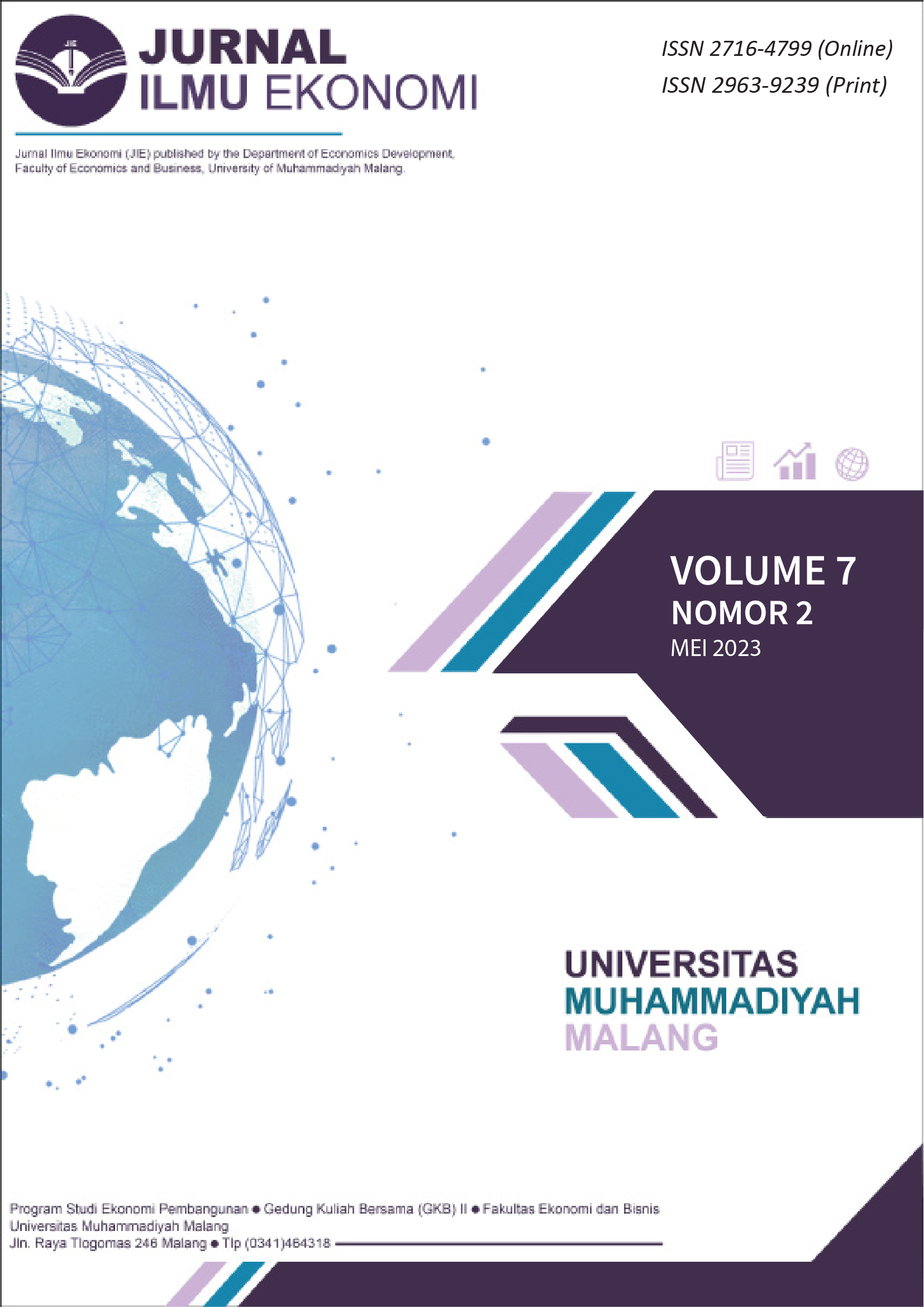Analisis Ketimpangan, Pola Pertumbuhan Ekonomi dan Sektor Unggulan di Kawasan Kedungsepur Provinsi Jawa Tengah
DOI:
https://doi.org/10.22219/jie.v7i02.24997Keywords:
Economic Regional, Leading Sector, indeks williamson, Location Quetiont (LQ), Static Location Quotient, Dynamic Location QuotientAbstract
One of the efforts regarding equitable development to accelerate regional economic development is through infrastructure development in priority areas and can also help restore the community's economy due to Covid-19 in the Kedungsepur Area, Central Java Province. Based on Presidential Regulation No. 79 of 2019 it is stated that increasing investment and economic growth in the region has an impact. To know the level of income inequality, economic growth patterns, and leading sectors for a decade. By using data obtained from one of the institutions, namely the Central Bureau of Statistics, is processed using the analysis techniques of the Williamson Index, Klassen Typology, LQ/SLQ-DLQ. The results of the analysis showed that the lowest level of inequality reached 0.179 in 2013 while for the growth pattern there was 1 fast growing and growing, 1 developing fast, 4 underdeveloped and leading sub-sectors that still had the potential to have 5 sectors with classification for the leading economic sector from 6 districts/cities there were 25 featured categories 32 mainstays, 19 prospective and 26 lagging
Downloads
References
Arifin, Z., & Wiyono. (2021). Analisis Ketimpangan Pola Pertumbuhan dan Sektor Ekonomi Unggulan di Kawasan Selingkar Wilis, Provinsi Jawa Timur. Thesis. Malang: Universitas Muhammadiyah Malang.
Arsyad, L. (1999). Pengantar Perencanaan dan Pembangunan Ekonomi Daerah. Yogyakarta: BPFE.
Arsyad, L. (2010). Ekonomi Pembangunan. Yogyakarta: UPP STIM YKPN.
Bada Pusat Statistika. (2021). Produk Domestik Regional Bruto Wilayah Kedungsepur Menurut Lapangan Usaha 2010-2020 Jawa Tengah. Retrieved from Bada Pusat Statistika Provinsi Jawa Tengah: https://jateng.bps.go.id/subject/52/produk-domestik-regional-bruto--lapangan-usaha-.html
Badan Pusat Statistik. (2021). Presentase Tingkat Kemiskinan Kabupaten/Kota 2016-2020. Retrieved from Badan Pusat Statistik Provinsi Jawa Tengah: https://jateng.bps.go.id/indicator/23/34/1/kemiskinan.html
Badan Pusat Statistika. (2021). Proyeksi Penduduk Kabupaten/Kota Provinsi Jawa Tengah 2010-2020. Retrieved from Badan Pusat Statistika Provinsi Jawa Tengah: https://jateng.bps.go.id/indicator/12/88/1/proyeksi-penduduk-2010-2020.html
BAPPEDA. (2021). Rencana Kerja Pembangunan Daerah Kabupaten/Kota 2016 – 2020 Provinsi Jawa Tengah. Retrieved from Badan Perencanaan Pembangunan Daerah Provinsi Jawa Tengah: https://bappeda.jatengprov.go.id/dokumen-publik/dokumen-perencanaan/rencana-kerja-pemerintah-daerah-provinsi-jawa-tengah/
Didia, K. A. (2016). Analisis Ketimpangan Pembangunan di Kawasan Kedungsepur. Economics Development Analysis Journal, Vol. 5(1): 101-109. http://journal.unnes.ac.id/sju/index.php/edaj
Diskominfo Jateng. (2019, Februari 26). Portal Berita Pemerintah Provinsi Jawa Tengah. Retrieved from Pejabat Pengelola Informasi dan Dokumentasi Provinsi Jawa Tengah: https://jatengprov.go.id/publik/rabu-musrenbangwil-eks-karesidenan-semarang-dibuka/
Djojohadikusumo, S. (1994). Perkembangan Pemikiran Ekonomi: Dasar Teori Ekonomi Pertumbuhan dan Ekonomi Pembangunan. Jakarta: Pustaka LP3ES.
Kuncoro, M. (2006). Ekonomi Pembangunan. Jakarta: Penerbit Salemba Empat Jakarta.
Latumaerissa, J. (2015). Perekonomian Indonesia dan Dinamika Ekonomi Global. Jakarta: Mitra Wacana Media.
Putra, A. N. (2013). Analisis Potensi Ekonomi Kabupaten dan Kota di Provinsi Daerah Istimewa Yogyakarta. Skripsi. Jakarta: UIN Syarif Hidayatullah Jakarta.
Richardson, H. (1977). Dasar-Dasar Ilmu Ekonomi Regional (terjemahan: Paul Sitohang). Jakarta: LPFE-UI.
Siafrizal. (2012). Ekonomi Regional, Teori dan Aplikasi. Padang: Baduose Media 2008.
Soebagiyo, D., & Hascaryo, A. S. (2015). Analisis Sektor Unggulan Bagi Pertumbuhan Ekonomi Daerah di Jawa Tengah. The 2nd University Research Colloquium (pp. 138-151). Semarang: LPPM Universitas Muhammadiyah Semarang.
Soepono, P. (2001). Teori Pertumbuhan Berbasis Ekonomi (Ekspor): Posisi dan Sumbangannya Bagi Perbendaharaan Alat-alat Analisis Regional. Jurnal Ekonomi & Basis Ekonomi, Vol. 16(1): 41-53. https://doi.org/10.22146/jieb.6802
Sunarmoko, M. (2002). Ekonomi Publik untuk Keuangan dan Pembangunan Daerah. Yogyakarta: Andi Yogyakarta.
Sutrisno, A. (2012). Analisis Ketimpangan Pendapatan dan Pengembangan Sektor Unggulan di Kabupaten dalam Kawasan BARLINGMASCAKEB tahun 2007-2010. Economics Development Analysis Journal, http://journal.unnes.ac.id/sju/index.php/edaj.
Syarifuddin, T., & Zulham, T. (2018). Analisis Sektor Unggulan dan Pengaruhnya Terhadap Pertumbuhan Ekonomi di Kabupaten Nagan Raya Provinsi Aceh. Jurnal Ilmiah Mahasiswa Ekonomi Pembangunan, Vol. 3(4): 844-851. http://www.jim.unsyiah.ac.
Tadipedin, M., Suharyo, I., & S, M. (2001). Aspirasi Terhadap Ketidakmerataan: Disparitas Regional dan Konflik Vertikal di Indonesia. Jakarta: UNSFIR Working Paper.
Usya, N. (2006). Analisis Struktur Ekonomi dan Identifikasi Sektor Unggulan di Kabupaten Subang. Skripsi. Bogor: Institut Pertanian Bogor.
Zuswanto. (2014). Analisis Spasial Pertumbuhan Ekonomi Kawasan Kedungsepur (Kendal, Demak, Ungaran, Kota Semarang, Kota Salatiga, dan Grobogan) Provinsi Jawa Tengah Tahun 2008-2012. Skripsi. Surakarta: Universitas Muhammadiyah Surakarta.
Downloads
Published
How to Cite
Issue
Section
License
Copyright (c) 2023 Faza, D. A., Susilowati, D., Arifin, Z.

This work is licensed under a Creative Commons Attribution-NonCommercial-ShareAlike 4.0 International License.
Authors who publish with this journal agree to the following terms:
- For all articles published in the JIE (Jurnal Ilmu Ekonomi), copyright is retained by the authors. Authors give permission to the publisher to announce the work with conditions. When the manuscript is accepted for publication, the authors agree to the automatic transfer of non-exclusive publishing rights to the publisher.
- Authors retain copyright and grant the journal right of first publication with the work simultaneously licensed under a Creative Commons Attribution-NonCommercial-ShareAlike 4.0 International License that allows others to share the work with an acknowledgement of the work's authorship and initial publication in this journal.
- Authors are able to enter into separate, additional contractual arrangements for the non-exclusive distribution of the journal's published version of the work (e.g., post it to an institutional repository or publish it in a book), with an acknowledgement of its initial publication in this journal.
- Authors are permitted and encouraged to post their work online (e.g., in institutional repositories or on their website) prior to and during the submission process, as it can lead to productive exchanges, as well as earlier and greater citation of published work (See The Effect of Open Access).
This is an open access article and licensed under a Creative Commons Attribution-NonCommercial-ShareAlike 4.0 International License








